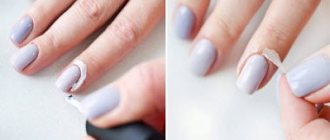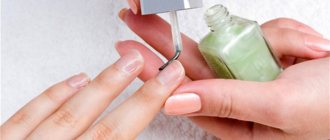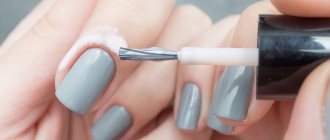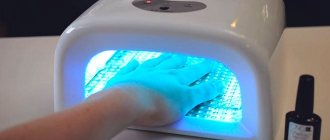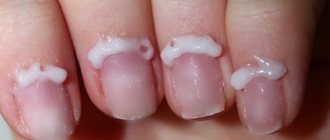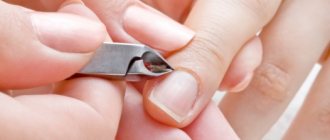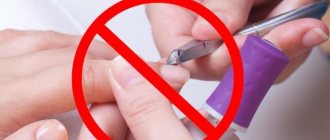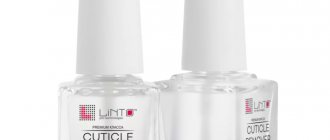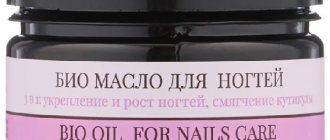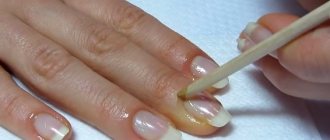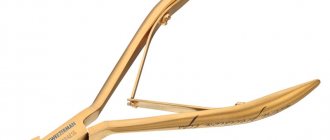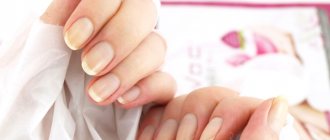Products for protecting skin from varnish during manicure. Their use and removal.
A beautiful manicure is the key to a girl’s good mood. There are quite a lot of techniques for performing it, so even experienced ladies who practice home manicure sometimes face the need to wipe off excess varnish from the skin of their fingers and cuticles.
If you notice any nail polish outside the nail plate and manage to immediately remove it with a cotton swab dipped in acetone, then beauty on your fingers is guaranteed. And if not, you will have to scrub it for a long time.
Salon professionals know a number of ways to prevent such inconvenience.
Let's consider these methods in more detail.
What do you cover your fingers with to protect them from nail polish during manicure? What is the name of the product?
Defender in the girl's hands and on her fingers after applying varnish
Among the means to protect the skin around the nail plates and the fingers themselves during manicure are:
- scotch
- PVA glue
- rich hand or face cream
- petrolatum
- cuticle softener
- liquid tape, or liquid latex
- protective liquid
- Skin Defender
If the first four can safely be attributed to improvised means for home manicure, then the last three are definitely for professionals.
You will find Skin Defender in a pink bottle with a special brush. However, there are also ordinary ones - white ones with the usual brush, as for applying varnish.
The liquid tape has a pleasant mint color. The brush in the bottle is identical to the varnish brush.
Each of the listed products has proven itself well for specific types of manicure.
PVA glue for manicure around the nail as a liquid tape
When performing stamping, water manicure and other nail art options, you can use PVA glue for manicure around the nail.
It would seem that this is a completely irrelevant substance in this case. However, experienced craftsmen will tell you that the properties that such an adhesive composition has are very beneficial to use to protect the skin from the risk of becoming contaminated with residues of varnish, gel polish or gel. We recommend: What is nail stamping and its benefits
PVA glue does not need to be prepared or mixed with other components; just open the tube cap and squeeze the product onto the skin. Gently spread it over the skin with a thin brush, not forgetting to check the space close to the nail. Next, the composition should be allowed to dry thoroughly; when this happens, a thin but very reliable protective film will remain on the skin, which will not allow decorative varnish, gel polish or gel to stain the skin around the nail and thereby ruin the appearance of the entire manicure.
After the glue has dried, you can create a nail art design. And when it is completed, you only need to remove the remaining glue from the surface of the skin. This is not difficult at all, just use tweezers; with this tool, the adhesive film is removed from the skin.
How to remove nail polish from a finger around a nail?
liquid tape - applied to the finger and removed after the varnish has hardened
The most convenient way is to use liquid tape, defender or PVA glue. They are removed with a film after the varnish has dried on the fingers.
- To do this, use tweezers. With one end, pry the edge of the film on the skin, press it with the other and gently pull it up and to the side. Or use a wooden stick to separate part of the dry film from the skin and pick it up with tweezers.
- The stained surface will be easily removed and leave clean skin and a beautiful edge along the nail line.
The second method is to quickly wipe off excess fresh polish with cotton wool soaked in nail polish remover.
A number of other proven methods:
- correction marker,
- a toothpick or match with a thin layer of cotton wool wrapped in it, which should be dipped in acetone before use,
- synthetic thin brush, dry cloth and nail polish remover. Dip the brush into the liquid and move it forcefully over the stained areas of the cuticle and skin ridges. Wipe the brush on a napkin, dip it in the liquid again and rub it 2-3 times over the same places without pressing.
- cuticle oil or regular sunflower oil,
- a hot shower an hour after the manicure has dried, followed by a massage of the cuticle areas and skin ridges with a terry towel
- washing hands with soap and then moisturizing the skin with cream. This way you will soften the varnish on areas of the skin and easily remove it, for example, with a towel or scraping,
- orange stick. The technique for using it is similar to using a toothpick with cotton wool. Therefore, keep nail polish remover and a napkin on hand to blot the stick before treating the stained areas.
So, we looked at a number of ways to prevent polish from spreading on the skin and cuticles during manicure procedures. We determined their effectiveness for different types of manicure.
If you are an adherent of any particular method of protecting your hands during manicure, then it’s time to try an alternative and get your experience and opinion on the ease of use.
Effective and simple ways to protect cuticles from nail polish
The process of painting nails is a fairly simple procedure, but only at first glance. Agree, even with a “stuffed” hand, it’s rare to apply polish without errors, and without special skills, it even turns out that there’s more polish on the cuticle and side ridges than on the nail itself. Creative ladies have come up with all sorts of ways to remove unnecessary residues, but often instead of the expected result, the result is only even more smeared varnish. Getting out of this situation while maintaining your manicure is not so easy. But it’s much easier to avoid this by using a product to protect the cuticle from varnish.
As you may have guessed, it is used before, not after, applying the polish, thereby preventing it from getting on the skin. As a result, a lot of time and nerves are saved, not bad, isn’t it? It’s the little tricks that nail art professionals use that we’ll share with you today.
New product on the beauty market
If previously resourceful girls could quite easily handle a manicure using ordinary tape, the emergence of new drawing techniques has made this approach, to put it mildly, unproductive. Well, what fashionista doesn’t know about water manicure, ombre technique or stamping? But in the process of creating such creations, almost half of the finger remains dirty, and here you clearly cannot save yourself with tape, especially since when it comes into contact with water, its adhesive properties are completely lost. Treating with nail polish remover is also not an option: a large amount of work plus an unbearable smell for many will negate all the pleasure of a manicure.
As you know, the market is very sensitive to the emergence of new requests, and in this case, the result of the efforts of manufacturers is skin defender, a product for protecting the cuticle. Thanks to this product, all efforts to remove nail polish from leather can become a thing of the past. Now all you need to do is apply the composition to the area of skin that is being painted, wait for it to dry completely and make a drawing. Then simply remove the film. All. The manicure is smooth and beautiful, the fingers are clean! What more could you ask for?
The advantages of this product were appreciated not only by beauty salon specialists, but also by lovers of home nail art. Why did they like him so much? First of all this:
- Natural components in the composition, where synthetic components are completely replaced by rubber. At the same time, the liquid for protecting cuticles from varnish has a delicate pink tint and a pleasant aroma that persists even after drying;
- User-friendly design. The bottle is small in volume and does not take up much space, which is very convenient both for storing at home and while traveling. In addition, it has a very convenient brush that allows you to apply a sufficient amount of product without getting on the polish;
- Drying speed. The composition sets in a matter of seconds, which makes it possible to minimize the breaks between application stages;
- Wide range of applications. It can be used both for protective purposes and to create a variety of designs on the nails;
- Caring properties. The components of the product have antibacterial properties and also contribute to the rapid restoration of damaged skin areas.
Impressive, really. By the way, the price of this product is quite affordable, so any girl can afford such a small weakness.
Protecting the cuticle with improvised means
You don’t always have the time and opportunity to look for new products in beauty stores or wait for the delivery of a product purchased on the Internet, because you want to treat yourself to a fresh manicure right now. In such situations, quite ordinary things available in every home will come to the rescue: fatty cream, PVA glue or Vaseline.
The action of Vaseline is reduced to creating a dense lipid film, which becomes a barrier to paint penetration and is not washed off with water. When working with such protection, you need to be very careful, because once it gets on the nail plate, just like on the skin, it will not allow the varnish to attach well, thereby completely ruining the design. Removing the applied layer will not be difficult - just one “swipe” of a cotton swab, and the skin around the nail will be in perfect shape again.
A similar principle of operation applies to fatty cream. Here, however, it is important to choose the appropriate level of fat content, since a regular eye cream or hand moisturizer may not cope with the task due to insufficient density. The best option would be creams from the so-called “winter” series, which have a denser structure and high fat content. The operating rules are the same: apply the cream, apply makeup, remove the remaining residue with a cotton swab, and you can admire your beautiful nails.
Protecting cuticles from varnish using PVA is one of the simplest and most accessible methods. In no way inferior in its effectiveness to newfangled means, it costs literally pennies. The algorithm for working with glue is as follows:
- Using a brush, gently apply to the surface of the skin;
- Wait until completely dry and start painting your nails;
- At the end of the process, remove the formed film using a cotton swab or disk soaked in water.
The only precaution is to try to ensure that the fairly liquid glue does not spread when applied and does not get on the nail plate. Otherwise, it has no drawbacks.
What kind of gel is applied around the nail for a manicure?
At the very beginning, after removing the old gel polish, manicurists apply another product to the cuticle, which has a different purpose.
What gel to apply around the nail for manicure:
- This is a keratolytic - a skin softener. It helps eliminate cuticle adhesions in the nail area, soften the skin, and make it pliable. Most often, this product is used in a combined technique, when the cuticle around the nail is not removed using a cutter, but is cut with scissors or tweeters.
- This product is used if the cuticle is rubbery, oaky, or too wet. This often happens on nails with hyperhidrosis. A few minutes after degreasing and using alcohol, droplets of water appear.
- Due to the presence of a large amount of moisture in the skin, such cuticle is not cut using the device, and the pressure of the cutter on the skin causes a strong burning sensation and small wounds. Therefore, when performing a manicure on difficult hands, the master usually uses a remover. It's much easier to do a manicure with it. This saves time and helps remove roughness without using a cutter, but with the use of nippers or other cutting tools.
Below you can find the most common keratolytics for the cuticle:
- Cody
- CND
- Naomi
- Severina
Removing the coating
Skin defender for nails: reviews
Below you can read reviews from consumers who have used skin defender.
Skin defender for nails, reviews:
Olga. I’m not a manicurist, but a “me” person. I learned how to do a manicure after watching videos on YouTube. I’m good at it, but I consider stamping the simplest design option for myself. However, after it, traces of paint remain on the skin, which are difficult to remove. I took a risk and purchased skin defender. I was focusing on a low price category, so I purchased a product from corazon. It cost me only 70 rubles, but the bottle is small. It is quite suitable for home use, because the consumption is economical. It sticks well, the consistency is comfortable, does not spread over the surface of the nail, and is easily removed with a film, along with the remaining paint.
Oksana. I only do manicures for myself and my friends, so initially I didn’t want to spend money on useless products. Therefore, I often use PVA glue for such purposes. But it is very liquid and spreads, so the manicure is completely sloppy, with a lot of bald spots. It is difficult to wipe off glue residue from the nail. It was removed with liquid along with the remaining paint, and everything had to be done again. I was generous and bought a pink thing from Neil Ru. I am very pleased because the product works great. Lately, almost all of my girlfriends have been asking me to make a gradient. For these purposes I use air puffing, which leaves a lot of marks on the skin around the nail. This pink thing makes them easy to remove. Dries instantly and has a neutral odor. None of the friends had an allergic reaction.
Marina. I noticed the product immediately after it appeared on the market, but I thought it was some kind of deception. I thought the product was useless. How wrong I was. After water manicure with a lot of streaks came into fashion, as well as baby boomer, gradient and stamping, I purchased adhesive, liquid tape. I am very pleased, there are no marks left on my nails. I chose the product from born pretty. I ordered it in China on the Aliexpress website. I’m happy with the quality, I think it’s no different from expensive products. Works well, applies in a thin film and dries quickly. It is worth remembering that in winter the product freezes, and after defrosting the properties are not restored. The Chinese manufacturer did not warn me about this, so I made my first order in winter. After the product arrived, it was impossible to use it due to the large amount of flakes. The product separated into two parts: liquid and thick. After that, I made another order in the summer. A mass of medium consistency arrived, which resembles jelly. I use it with pleasure, I really like it, after stamping there are no traces left.
Thanks to its elasticity, the product is easily removed from the skin and does not tear. Together with it, the remaining dye is removed. Thus, the nail remains clean, without streaks or traces of paint.
Cuticle remover gel: how to apply?
There are several types of keratolytics, depending on the active substance. To soften them, fruit acids or alkalis are often introduced into their composition. Urea agents are also used. Sometimes urea-based drugs are used. The main purpose is to loosen the surface of the cuticle, skin, and facilitate its easy cleansing. The remover is applied depending on the manicure technique. Most often, this product is used in classic manicure and in combined techniques. Manicurists are trying to simplify the task by speeding up the work.
Cuticle remover gel, how to apply:
- After removing the gel polish and removing dust, apply a thin flame treatment to clean the subcuticular pocket and remove pterygium from the sinuses. Next, a keratolytic agent is applied to the cuticle surface and left for about 2 minutes.
- Remains of the product are removed with a damp cloth. Two to three minutes is enough for the skin in this area to become very soft and supple. It can be easily lifted with an orange stick and removed with a cutting tool.
- In classic manicure, apparatus and cutters are not used. Pull back the cuticle and release the subcuticular pocket using an orange stick or pusher. The remover is applied, and after its exposure, using orange sticks, scrape off the remains of the pterygium, and cut off the cuticle with a cutting instrument. These can be scissors, tweeters or manicure scissors.
- Remover or keratolytic is used not only in manicure, but also in pedicure, when treating fingers before applying gel polish.
Remover
